What to Do With Leftover Beef Fat
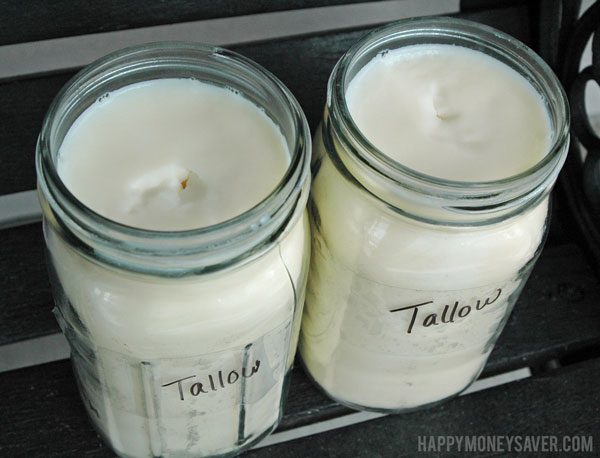
For today's Happy Homesteading post we are going back in history to learn the long-lost skill of rendering beef tallow fat like many pioneers made & used. Beef tallow was used in cooking as it makes an amazing oil for frying or pastries. They would also use tallow fat for candle making, soap making, moisturizing, keeping cast iron pots from rusting and even for waterproofing leather.
What is Tallow?
"Tallow is the rendered fat of cows, sheep, and other ruminant animals such as deer. It is very solid and waxy at room temperature and can be kept for extended periods without the need for refrigeration. Rendering is the process of gently heating the interior fat tissue, called "suet," causing the pure oils to melt away from the rest of the tissue." (Source)Tallow is solid at room temperature, with a texture harder and more waxy than shortening. In fact tallow and lard are rendered the same way, but lard is pig fat slowly melted down and is softer like shortening.
Beef Tallow is a Healthy Fat
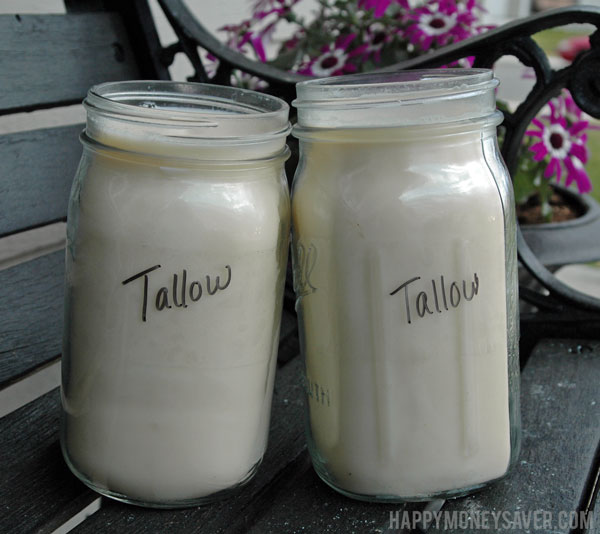
Tallow is the healthy fat that sadly got pushed off the shelves once vegetable oils came around.
Before doing this homesteading series I had honestly never heard of tallow. And when I asked my friends and family about this I just got weird looks. Isn't it amazing how something that was basically a staple in homes a hundred or two years ago has seemingly been lost or forgotten? After researching I found that beef tallow is actually a very healthy fat full of vitamins and is actually better for you than some of the hydrogenated oils we buy at the stores.
"Tallow is an excellent source of niacin, vitamins B6, B12, K2, selenium, iron, phosphorus, potassium and riboflavin. Grass Fed beef tallow contains high ratio of conjugated linoleic acid (CLA) which is a cancer-resistant agent. Contrary to the popular conception, tallow is good for health as tallow fat is similar to the fat/muscles in the heart. Recent studies have shown that human beings need at least 50% of saturated fats like tallow and lard to keep the heart pumping hale and healthy. Tallow from pasture-raised cows also contains a small amount of Vitamin D, similar to lard. It is also a good source of K2 in its suet form." (Source)Making Tallow
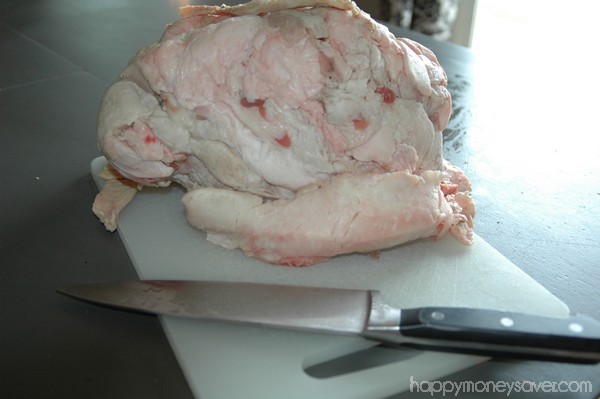
First thing you need is some beef fat. I found a nice local butcher shop, called them up and asked if they had any beef fat. Lucky for me they did and it was only $.67 per lb too. For the nicest and healthiest tallow try to get beef fat from right around the kidneys and preferably from a grass-fed cow. I didn't ask the butcher at the time I purchased it if this was a grass-fed cow or not, I think I was in shock that I actually found beef fat and that it was so inexpensive. But next time I will ask for sure.
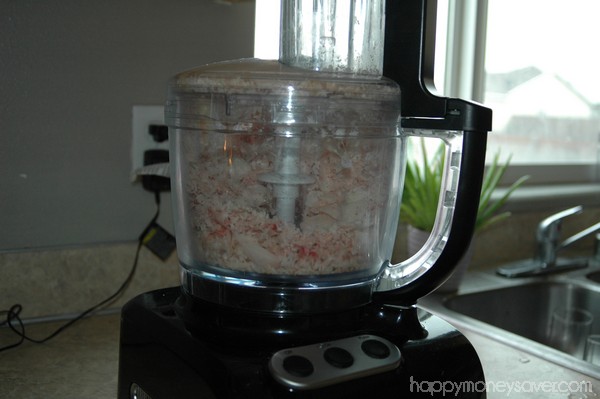
The beef fat I purchased was frozen, so I let it thaw enough that it was still hard but not frozen solid so I could use my food processor to grate it up. If you don't have a food processor just use a knife and cut the fat into as small of chunks as you can. If there are any pieces of meat you can cut out do it at this stage too.
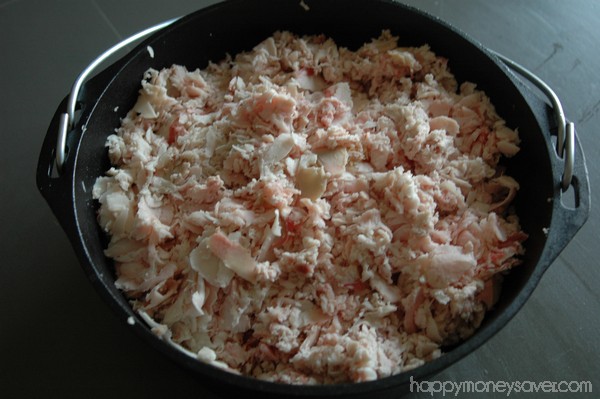
Here is all my beef fat put into my 5 qt. Dutch Oven I purchased. I think there is about 4 lbs of beef fat in there. I filled my pan to the top.
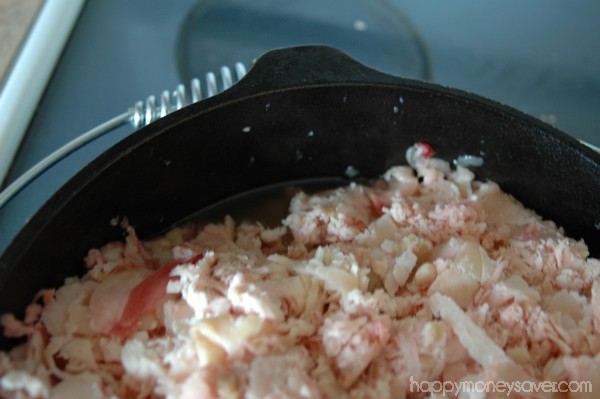
With the heat on low I put the lid on the beef tallow fat and let it start slowly cooking. Here is how it looked after 1 hour. If you had only 1 lb of fat it would look a lot more melted at this stage, but since I have 4 lbs, it is slowly cooking from the bottom.
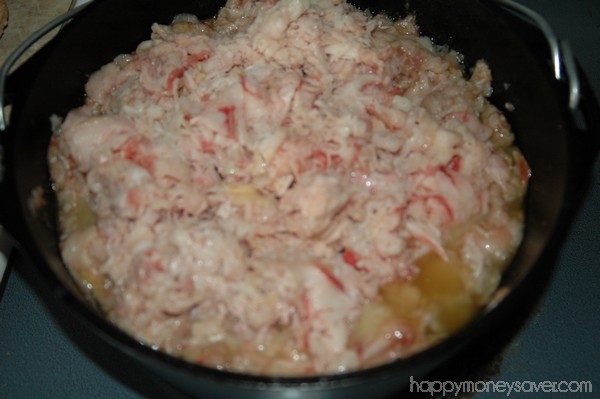
Here it is again after 2 hours. A little more rendered. At this point I took a wooden spoon and mixed the beef tallow fat around a bit. Some people like to take a potato masher and squish it a bit too to help the process along. You don't want to cook this fast because if it burns it will ruin it all.
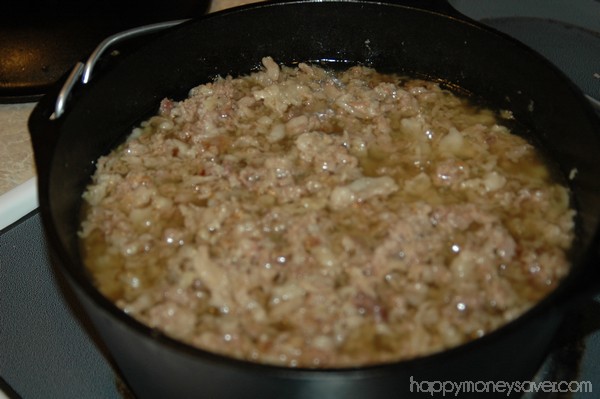
Now its been 4 hours and my house is REALLY starting to smell bad like well..FAT and STINKY OIL. YUCK.

I opened up every window and turned on fans. I can't stress to you enough how horrible this smelled. At this stage I was just wanting this whole process to be over. I am not kidding. I spent most of the day upstairs just so I couldn't smell it as much. Then when I did have to go downstairs I actually gagged once from the smell. I am such a baby, aren't I… 🙂
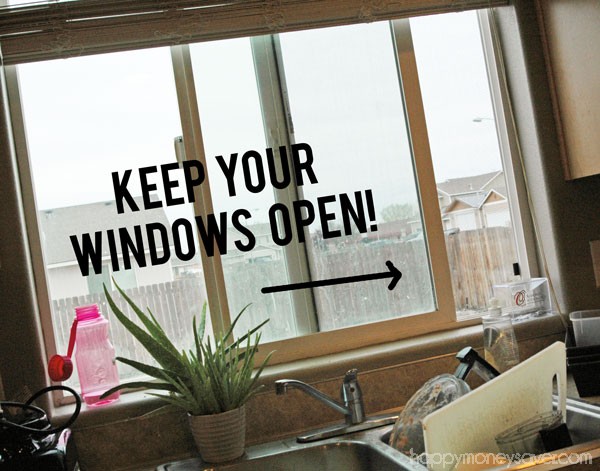
After about 6-7 hours it was all done. You can tell by all the little browned bits cooked till crispy. The Pioneers called these the cracklin's. They are basically fried bits of meat and grisle. They would sprinkle a little salt on the cracklins and once cool eat them up. I shuddered at the thought after smelling the fat cooking in the air. I actually lost my appetite with the smell in the air.
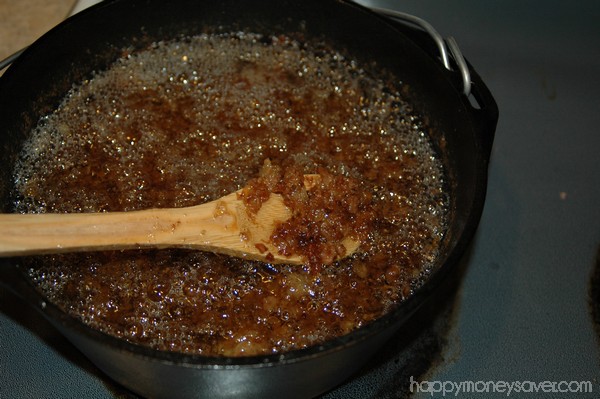
Next is the time to drain all the liquid oil and strain out the cracklin's. You can use a fine mesh strainer, a paper towel, cheese cloth or what I used: a flour sack towel. I lined the towel over a strainer, which sat over a large bowl.

Then I poured all the hot oil in and strained it. Use oven mitts here, and remember to be safe. This is REALLY HOT oil and can burn you if you are not careful.
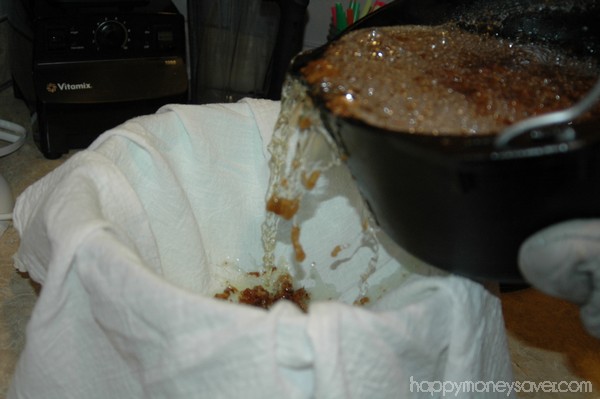
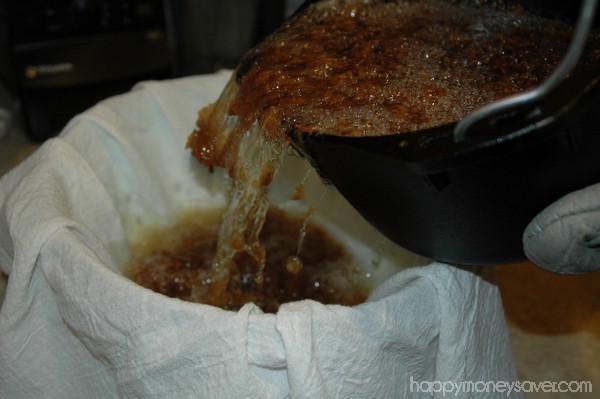

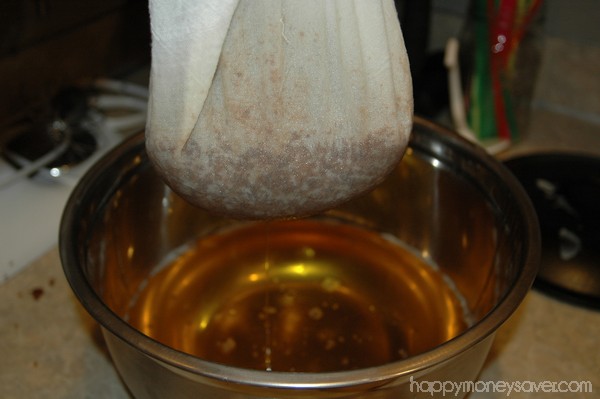
Look at all that lovely yellow liquid tallow left behind after the straining.

It should be a nice yellow color.
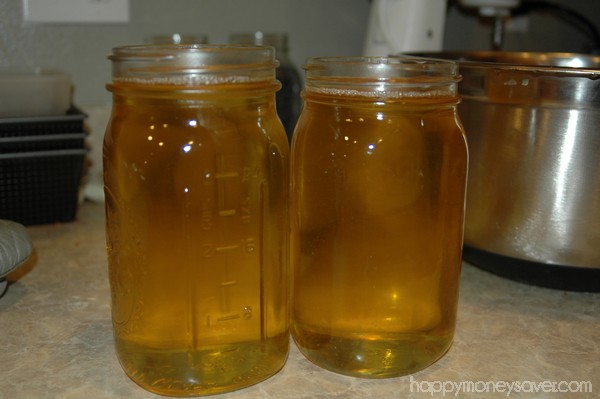
I poured mine into wide mouth glass jars for storage. Then I let it cool all night.
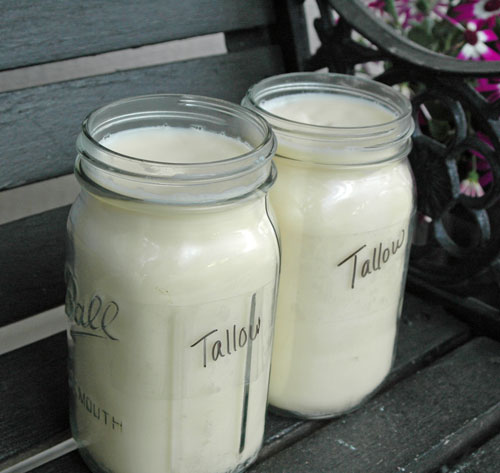
And it turned hard and waxy and white. Isn't it beautiful??
It was even more beautiful after I deep cleaned my whole kitchen, using vinegar to get the nasty smell out. 😉

Storing Tallow
Beef Tallow is wonderful because as long as you store it in an air-tight container to avoid oxidization it can be at room temperature for up to a year or longer. I have mine in my fridge as it will last even longer there. OR you can pour your tallow fat into ice cube trays and put the frozen cubes into a freezer bag to freeze.
Tallow Soap & Tallow Candles
As many of you might know I made my own homemade soap for the first time last month using a recipe of lye and a variety of store bought oils. I love the soap I made, but I wanted to make soap like the Pioneers and settlers did from long ago using beef tallow. I have heard that homemade tallow soap made from rendering beef tallow is the very best type of soap. It's strong, its hard and it suds nicely. And I would like to use my own tallow soap instead of using Fels Naptha in my Homemade Laundry Soap recipe as well. So check back, I will be making tallow soap from scratch very soon! Plus I think it might be neat to try to make Tallow candles as well.
So what do you think? Do you have questions? Think this is weird? Please leave a comment with your thoughts!
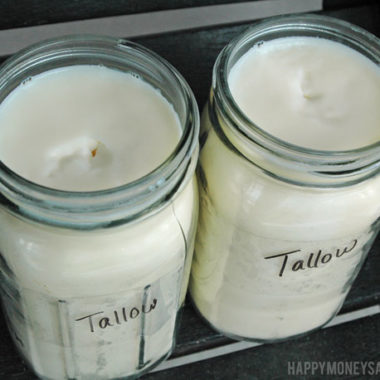
- Beef Fat preferably from a grass-fed cow and try to get the fat that is from right around the kidneys
-
Use food processor to grate it up or if you don't have a food processor just use a knife and cut the fat into as small of chunks as you can.
-
If there are any pieces of meat you can cut out do it at this stage too.
-
Put beef fat into 5 qt. Dutch Oven, fill pan to the top.
-
With the heat on low put the lid on the beef tallow fat and let it start slowly cooking.
-
After 2 hours take a wooden spoon and mix the beef tallow fat around a bit. Some use a potato masher and squish it a bit too to help the process along.
-
Don't cook this fast because if it burns it will ruin it all.
-
Stir again at about 4 hours.
-
After about 6-7 hours it will be done. You can tell by all the little browned bits cooked till crispy.
-
Next drain all the liquid oil and strain out the cracklin's. (Cracklins are basically fried bits of meat and gristle)
-
Use a fine mesh strainer, a paper towel, cheese cloth or a flour sack towel and line the towel over a strainer, which should sit over a large bowl.
-
Pour all the hot oil in and strain it. It should be a nice yellow color.
-
Pour into airtight containers and allow to cool overnight.
-
Store it in an air-tight container to avoid oxidization it can be at room temperature for up to a year or longer. You can store it in the fridge as it will last even longer there. OR you can pour your tallow fat into ice cube trays and put the frozen cubes into a freezer bag to freeze.
Source: https://happymoneysaver.com/how-to-render-beef-tallow/#:~:text=Beef%20tallow%20was%20used%20in,and%20even%20for%20waterproofing%20leather.
0 Response to "What to Do With Leftover Beef Fat"
Post a Comment